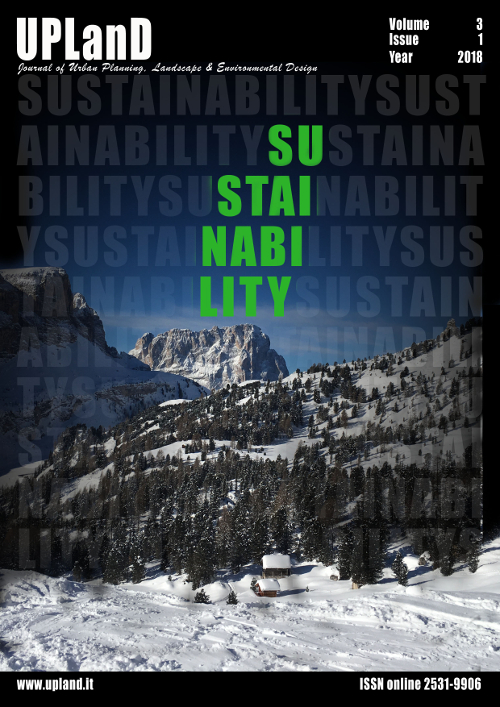Urban regeneration of Medellin. An example of sustainability
Main Article Content
Abstract
The city of Medellin has suffered a chaotic urban growth since early twentieth century, caused by the echoes of industrialization suffered in its historical fabric and by the migration of people from the countryside to the city. As a consequence, the central areas were abandoned and numerous peripheral pieces were built which drowned the traditional city. In this way, the regular and orderly original city became composed mainly of disconnected peripheral tissues, lacking in organization, infrastructures and minimum services, unhygienic fabrics with inhuman living conditions on which delinquency and marginality also grew, becoming the most dangerous areas of the city.
The urgent solution to the problems unleashed brought with it the realization of a series of urban and social reforms. The construction of a new way of transport was a definitive agent in the sustainable regeneration of the city. At this point we have the purpose of this research that aims to highlight the role of metro-cable in the process of urban regeneration, transforming Medellín from being one of the most dangerous cities in Colombia to an example of sustainability.
Downloads
Article Details

This work is licensed under a Creative Commons Attribution-NonCommercial-NoDerivatives 4.0 International License.
Authors who publish with this journal agree to the following terms:- Authors retain copyright and grant the journal right of first publication with the work simultaneously licensed under a Creative Commons Attribution License that allows others to share the work with an acknowledgement of the work's authorship and initial publication in this journal.
- Authors are able to enter into separate, additional contractual arrangements for the non-exclusive distribution of the journal's published version of the work (e.g., post it to an institutional repository or publish it in a book), with an acknowledgement of its initial publication in this journal.
- Authors are permitted and encouraged to post their work online (e.g., in institutional repositories or on their website) prior to and during the submission process, as it can lead to productive exchanges, as well as earlier and greater citation of published work (See The Effect of Open Access).
References
Alcaldía de Medellín (2006). Generalidades, Medellín y su población. Retrieved from https://www.medellin.gov.co/irj/go/km/docs/wpccontent/Sites/Subportal%20del%20Ciudadano/ Plan%20de%20Desarrollo/Secciones/Informaci%C3%B3n%20General/Documentos/POT/ medellinPoblacion.
Alcaldía de Medellín & BID. Medellín (2008). Transformación de una ciudad. Medellín, Colombia. Retrieved from http://www.eafit.edu.co/centros/urbam/Documents/libro.pdf.
Alcaldía de Medellín (2012). Resumen Plan de Desarrollo 2012 – 2015. Medellín Colombia, Ed. Dirección General de Comunicaciones, Alcaldía de Medellín.
Barton, J. (2008). Ciudad, Poder, Gobernanza. En G. Yáñez et al. (Eds.), El Poder de la Gobernanza: el ‘eslabón perdido’ de la sostenibilidad urbana. (pp.413-430). Santiago, CL: EURE libros.
Castrillo, M., Matesanz, Á., Sánchez, D., & Sevilla, Á. (2014). ¿Regeneración urbana? Deconstrucción y reconstrucción de un concepto incuestionado. PAPELES de Relaciones ecosociales y cambio global, 126, 129-139.
Dávila, J. D., & Daste, D. (2011). Medellin’s aerial cable-cars: social inclusion and reduced emissions. Cities, Decoupling and Urban Infrastructure, UNEP - IPSRM Cities Report (forthcoming).
Dávila, J. D., & Daste, D. (2011). Pobreza, participación y metrocable. Estudio del caso de Medllín. Boletin CF+S 54. La ciudad a escala humana. XII Congreso Anual N-aerus.
Echeverri, A., & Orsini, F. (2010). Medellín Medio Ambiente, Urbanismo, Sociedad . Medellín: Fondo Universidad EAFIT.
Gehl, J. (2008). La humanización del espacio urbano. La vida social entre los edificios. Barcelona, ES: Ed. Reverte.
Hernández, A., Alguacil, J., Medina, M., & Moreno, C. (2000). La ciudad de los ciudadanos. Madrid, ES: ed: Ministerio de Fomento.
Jacobs, J. M., Cairns, S., & Strebel, I. (2007). A tall story... but, a fact just the same: The Red Road high-rise as a black box. Urban Studies, 44(3), 609-629. doi: 10.1080/00420980601131910
Lerner, J. (2006). Conference. Cómo pensar una ciudad. Buenos Aires, 2006. Retrieved from https://www.youtube.com/watch?v=lXGY0X-wdjI
Monclús, F. J. (2003). El modelo Barcelona .Una formula original? De la reconstrucción a los proyectos urbanos estrategicos (1997-2004). Perspectivas Urbanas / Urban Perspectives, 18(4), 399–421.
Ureta, S. (2008). To move or not to move? Social exclusion, accessibility and daily mobility among the low-income population in Santiago, Chile. Mobilities, 3(2), 269-289.
Zúñiga, P., & Rodríguez, S. (2017). ¿De la ciudad violenta a la ciudad sostenible? Análisis crítico desde el desarrollo urbano sostenible de Medellín, Colombia 1913-2015. Barcelona. Revista bibliográfica de geografía y ciencias sociales, 22, 1-16.

